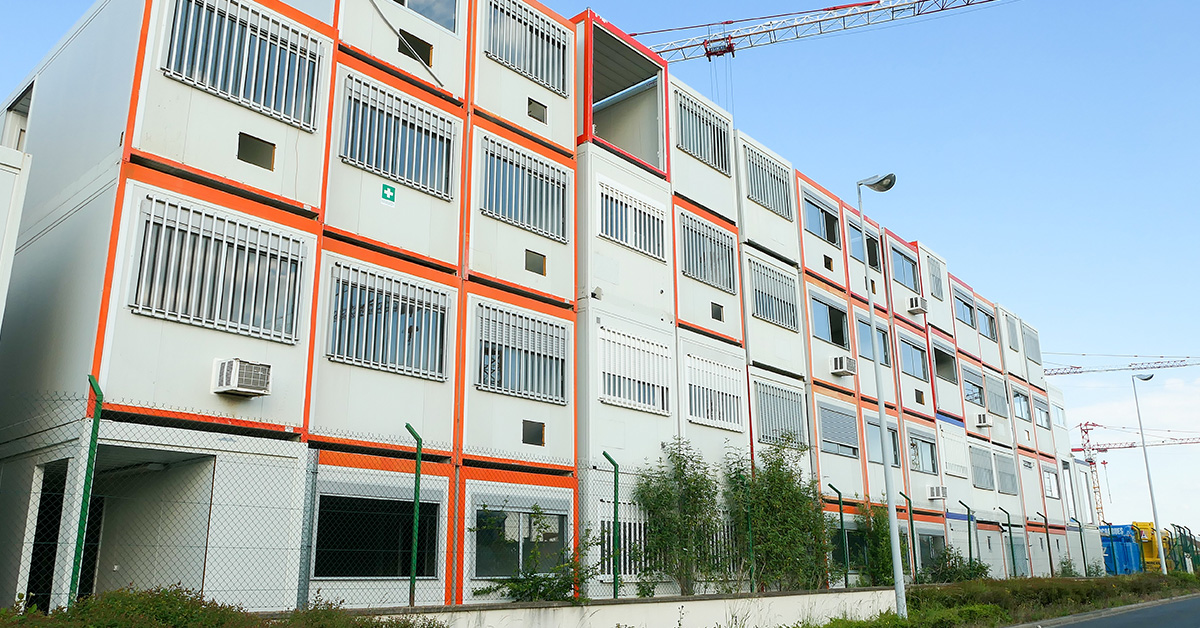Modular buildings are an effective alternative to traditional buildings by offering versatility, speedy construction and lower costs. These modular structures are prefabricated and then assembled on-site, and can be used by a company either temporarily or permanently.
They cost significantly less to produce, take less time to build, generate less waste and can involve practically any type of design.
Before modular buildings become a mainstream commercial real estate product, however, there is a significant stumbling block: financing. Banks typically will not fund the construction and purchase of a modular building. The popularity and acceptance of factory-built commercial buildings has been growing, however, and is increasing the need for mortgages. Given its flexibility and cost savings, the prospects for future growth of this construction segment remain good, which will create more opportunities for commercial mortgage lenders and brokers.
Modular advantages
A modular building is constructed off-site under controlled plant conditions, adhering to the same code standards and materials as traditionally built facilities. The modules are then assembled on- site. Anywhere from 60% to 90% of the manufacturing is completed inside a factory, according to the Modular Building Institute.
A prefabricated building can be designed with the same specifications as the most sophisticated traditional building but with 30% to 50% fewer costs, the Modular Building Institute reported. This is because companies can more efficiently control the construction workflow and timeline in a factory, reducing waste and the need for skilled laborers.
The controlled factory environment also tends to lower the risk of workplace accidents and eliminates weather delays which, in turn, saves time and money. The typical cost of the modular steel building is about $55 to $60 per square foot, which compares favorably to the $160 to $170 per-square-foot price tag for traditional buildings.
Another advantage is flexibility. Modular construction has nearly limitless design options. Permanent modular buildings, which are designed to last more than 20 years, are commonly used as schools, hotels or business complexes. Other building types are specifically designed to be temporary. These temporary facilities are generally smaller and are often used as office space on mobile job sites or as emergency medical stations.
Financial factors
The modular construction industry can be divided into residential, commercial, health care, education and industrial segments. According to the market research company Reports and Data, this industry had a global market size of $120 billion as of 2019, which was projected to grow by about 6% annually to $192 billion in 2027. The modular commercial sector alone was valued globally at $17.6 billion in 2019, and analysts predicted significant growth in the U.S. for modular hotels and offices.
In the U.S., the modular industry has already seen tremendous growth in recent years. Revenues from permanent modular construction totaled $3.3 billion in 2016, a 62% increase from 2015, according to a 2019 Cornell University study. The industry also has attracted investments from SoftBank’s Vision Fund and Amazon’s Alexa Fund.
Although modular construction has gained popularity, financing remains a hurdle. Banks have tended to shy away from funding these projects in the U.S. There are three major hurdles to overcome, according to the Cornell study. First, the material and overhead costs associated with the production process can be as much as 60% of the module’s cost. In many cases, manufacturers expect an upfront payment of 50% for the procurement of raw materials to construct the walls, floors and bathrooms. So, the property owner needs to make an upfront investment well before any part of the building is assembled on-site. In the case of large projects, the initial investment can run as high as $20 million.
Banks also are hesitant to finance modular buildings because it is more difficult to view the collateral. With a traditional construction project, a lender can visit and monitor the site. The progress is evident to a lender, which typically releases funds as construction targets are met. With modular construction, however, the prospective borrower has little to show the lender. The building is manufactured in segments behind factory walls and is typically far away from where final assembly will occur. Some lenders will only release the loan proceeds when the modular building is assembled on-site.
Another issue for traditional lenders is that modular construction is relatively new. There are far fewer modular commercial buildings to evaluate than traditional buildings. This makes it more difficult for a lender to place a value on the asset. Also, the industry is still in a growth phase and has relatively few U.S. manufacturers doing large projects. There can be unpredictable scheduling and pricing issues. Bank underwriters do not like ambiguity. So, it will likely take some time for the modular construction industry to overcome these challenges.
Overcoming hurdles
Although financing for modular buildings remains complicated, it isn’t impossible. Private lenders are a natural candidate to fill the void. Unlike banks, private commercial lenders are not subject to stringent regulatory and internal restrictions. A private lender typically has more flexibility to work in emerging markets and is more willing to pioneer new loan products.
The significantly shorter construction timeline and the lower risk of weather-related delays bode well for the future growth of the modular industry. Any investor, however, needs to understand that there are risks with each project. As with traditional construction projects, the solution to the funding hurdles lies in identifying the risks and attempting to minimize them.
In this industry, it is important for the investor to choose their manufacturer wisely. The reputable builder will regularly update lenders and investors as the building progresses from design to finished product. The design stage is a crucial part of modular construction, given that altering the design is difficult once construction has started in the factory. A reputable modular-building supplier will lay out all the options, including leasing options for companies that need a quick solution for temporary needs.
Today, the success of modular construction depends on institutional lenders becoming comfortable with this new way of building. Slowly but steadily, we will see more lenders favoring modular investments, giving the green light to more projects. ●
Author
-

Amanda Wilson is a freelance journalist specializing in commercial construction.





